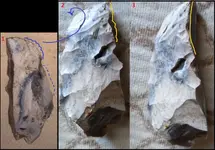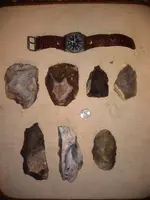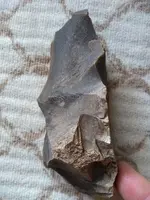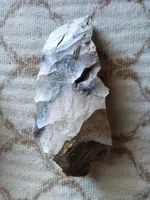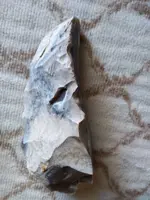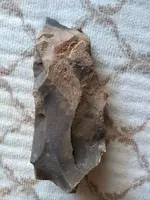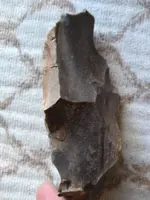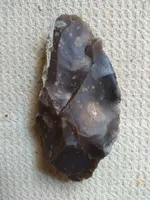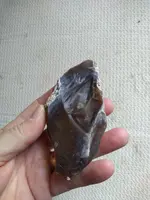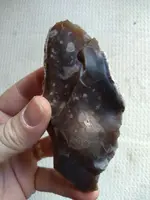Thanks
Every piece you've shown appears to have human intervention. (very likely)
I'll address this one because it has enough evidence to move it from "discard/debitage" to actual tool.
Pic 1 (below) appears to show, at least, secondary chipping along that one edge. It actually suggests "use wear".
That feature is in exactly the right spot ... coupled with the opposite edge, (the break line that is thick and flat), ... it has all the traits of a
"Backed Knife". Check out a butter knife ... is it flat on the back where you might push with your hand or finger ? ... same trait on this stone of yours.
Pic 2 you want to closely examine that flip side (arrow) to confirm very small, uneven chip scars and very minor breaks, to confirm "use wear".
We see that the lower edge is thick and and shows no secondary chipping, (basal chips) ... from this we can determine that the intention was never to haft this tool ... it was meant, and used, strictly as a hand-held tool.
The interesting and unusual feature is the clear use wear that has occurred on the "flat edge" side.
Almost always, these tools are used as shown in Pic 1 ... but we see the majority of use on this piece is on this other edge. It looks like they used the normal edge and found that the other side worked well and so they went with it, as well, as they worked.
Pic 3 strongly supports our suppositions ... the working edge is shown to be plenty sharp enough to work as a knife ... and it also shows a nice, gentle curve which allows the user to use it both as a knife and a scraper.
Suggests a butchering tool, meant to cut and scrape without the need of a second tool.
Again, we see the thick base, that shows this was never meant to have a handle.
Could have other uses, such as cutting and peeling sticks ... but, is a very very common style for butchering.
Summation: Looks like a complete tool ... looks like it was used ... is a common style that was often quickly made, possibly used for a single job ... and may have been discarded. These were quick and easy to make, so this is definitely a possibility.
The unique thing is that double edge feature that shows activity on the flat-edge side of the stone, in addition to activity on the opposing edge.
(Double edged knives were a common tool, BUT, they were not normally made in this fashion.)
